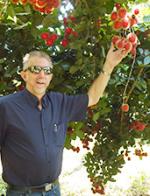
What requirements must fresh fruit and vegetables meet to be allowed on the European market?
The European fruit and vegetable market is very competitive. You must meet several requirements to export to this market. These can be rules from the European Union or set by buyers. Private requirements are known as 'certifications'. Most certifications in Europe focus on social and environmental issues. Their primary goal is to safeguard European consumers. Some certifications cater to specific niche markets.
Contents of this page
1. What are the mandatory requirements for fresh fruit and vegetables?
Mandatory requirements cover food safety and quality. These requirements change regularly. You can find a list of these requirements using My Trade Assistant on Access2Markets or ITC’s Global Trade Helpdesk. For details about your product, enter the product name and the country you are exporting from.
The Generalised Scheme of Preferences (GSP) enables developing countries to pay reduced or zero duties on their exports to the European Union (EU). The list of GSP beneficiary countries is split into three different categories:
- Standard GPS, for low and lower-middle income countries.
- GSP+, a special incentive arrangement for sustainable development and good governance.
- EBA (Everything But Arms): the special arrangement for least developed countries (LDCs).
Limited use of pesticides
The EU often updates the Maximum Residue Levels (MRLs) for pesticides permitted in food products. You can find the list of approved pesticides on the Directorate General of Health and Food Safety website.
Remember to use only plant protection products (PPPs) that are permitted in your country. Using unauthorised products or PPPs intended for other crops may lead to rejection. You can find additional information on the PPPs permitted in your country on the Cabi BioProtection Portal.
MRLs are implemented via European Directives. This allows EU Member States to adopt tougher regulations than what European laws demand. Supermarkets in the Netherlands, Germany, Austria and Scandinavia are recognised for enforcing stricter MRLs. This also applies to exports to the United Kingdom.
If MRLs are exceeded, the first importer of the product may be held legally accountable. This is why more buyers request their suppliers to maintain records of the PPPs they use, as well as spraying records.
The Alert Cooperation Network (ACN) helps the regulatory agencies in EU countries to exchange information about products that have high levels of pesticides quickly. This allows for the quick removal of those products from the market. The ACN Annual Report 2023 highlights the importance of ensuring that food products meet maximum residue levels (MRLs). The information on official food controls below provides further information.
Tips:
- Use the EU Pesticide Database to find the relevant MRLs for your products. You can select your product or pesticide, and the database will show the list of associated MRLs. Always check whether your buyers have additional requirements for MRLs and pesticides.
- Implement GLOBALG.A.P. (Good Agricultural Practices). This is a private certification that many producers use to gain access to the EU market. It emphasises reducing chemical pesticide use and encourages sustainable farming practices. Buyers appreciate the integrated pest management (IPM) systems since they use a mix of eco-friendly strategies to manage pests without heavy reliance on chemicals.
Avoiding contaminants
Foodstuffs can contain contaminants. Contaminants are substances that are not added to food on purpose. They can come from many sources, including farming methods, pollution of the environment, packaging, transportation and storage. Some contaminants also occur naturally in certain foodstuffs. This is the case with hydrocyanic acid in cassava roots, for instance. The EU refers to these contaminants as “inherent plant toxins”.
Contaminants can also pose a risk to human health. The EU sets limits for contaminants in foodstuffs (see Table 1), as it does for MRLs. The most common contaminants in food are chemicals. These include heavy metals from pesticides (e.g. lead and cadmium), perchlorate and nitrates, which are often found in spinach, lettuce and arugula. Table 1 provides a general overview and range of maximum limits as of March 2025. For details for each specific product, check the Regulation (EU) 2023/915.
The rules for processed fruit and vegetables (such as dried fruit and juices) may differ. As the regulation is also regularly updated, you must keep yourself up to date. New insights into or threats to food safety and contaminants can always lead to adjustments in the regulations.
Table 1: Maximum limits of contamination of lead, cadmium, nitrates and perchlorate in fresh fruit and vegetables in mg/kg as of March 2025
| Lead | Cadmium | Nitrates | Perchlorate | |
| Fruits | 0.1 – 0.2 | 0.02 – 0.05 | ||
| Root and tuber vegetables | 0.1 – 0.8 | 0.02 – 0.2 | ||
| Fruiting vegetables | 0.05 – 0.1 | 0.02 – 0.03 | ||
| Brassica vegetables | 0.10 – 0.3 | 0.04 – 0.1 | ||
| Bulb vegetables | 0.03 – 0.05 | |||
| Leaf vegetables and herbs | 0.1 – 0.2 | |||
| Legume vegetables | 0.02 | |||
| Stem vegetables | 0.03 – 0.1 | |||
| Spinach, lettuce, arugula | 2,000 – 7,000 | |||
| Fruit and vegetables | 0.05 – 0.5 |
Source: Commission Regulation (EU) 2023/915 on maximum levels for certain contaminants in food (consolidated version of 1-1-2025).
Tips:
- Maintain good contact with your buyers because they will often keep you up to date with changes in regulation which affect the fresh fruit and vegetables business.
- Read more about contaminants on the European Commission website and find an overview of the maximum levels of certain contaminants in food in the Annex of Commission Regulation (EU) 2023/915. Try to check this information on an annual basis.
- Find out more about preventing and reducing lead contamination in the Code of Practice published by the FAO Codex Alimentarius. Also take a look at the European Commission’s fact sheet on food contaminants.
Microbiological criteria for pre-cut fruit
If you supply fresh, pre-cut fruit and vegetables, it is important to manage microbiological hazards throughout the processing and packaging stages. These hazards can cause foodborne illness. European Regulation (EC) No 2073/2005 (consolidated version 3-8-2020) sets out the details regarding sampling, testing methods and the micro-organisms you need to look out for. Salmonella and E. Coli are the two main bacteria tested in pre-cut fresh produce.
Tips:
- Develop a Hazard Analysis and Critical Control Point (HACCP) plan if you want to supply pre-cut fruits and vegetables. A HACCP will enable you to identify potential food safety hazards and keep them under control. Also take a look at certification schemes buyers ask for.
- Monitor the cold chain when delivering pre-cut fruit and vegetables. If you have experienced power cuts during storage, you must inform your buyer.
Official food controls
Food imported into the European Union (EU) is subject to official food controls. These controls include regular inspections that can be carried out at import (at the border) or later on once the food is in the EU, such as at the importer’s premises. The control is meant to check whether products meet legal requirements. Non-compliance with European food legislation is reported via the Rapid Alert System for Food and Feed (RASFF). If this happens, your product could be removed from the market. This usually results in a claim from your buyer.
The RASFF recorded almost 600 notifications for fresh fruit and vegetables in 2024. Most of these alerts (around 85%) were related to pesticide residues, with excessive chlorpyrifos residues being a major concern.
Source: GloballyCool compilation based on data from RASFF (February 2025)
18% of all pesticide-related cases involved chlorpyrifos, with more than half of these cases linked to produce from Turkey and Egypt. Chlorpyrifos is not the only banned organophosphorus pesticide residue often found in the EU. Other pesticides include dimethoate (found 17 times) and acephate (23 times).
Another frequently found pesticide residue was acetamiprid (37 times), a commonly used pesticide of the neonicotinoid pesticides group. Acetamiprid is allowed on fruit and vegetables in the EU. However, new, lower MRLs were introduced in 2025 for several fruits, including apples and pears, apricots, cherries, peaches and grapes. Lastly, formetanate (23x) completes the top five main pesticide residues. Formetanate is a frequently used carbamate pesticide but forbidden in Europe.
Source: GloballyCool compilation based on data from RASFF (February 2025)
Aside from pesticides, the most frequent issues were heavy metals contamination (28 cases) and microbiological hazards (mostly related to Salmonella). These categories ranked second and third in terms of the number of alerts.
Turkey dominates in terms of RASFF Notifications
A notable 25% of all RASFF notifications in 2024 involved products from Turkey, making it the leading country for reported issues. Egypt ranked second, accounting for 11% of notifications, followed by Kenya.
Kenyan challenges with green beans
Kenya has a reputation for being unable to consistently meet the EU’s legal requirements for green beans. Due to this, the beans have been subject to a 10% frequency of identity and physical checks in Europe for several years. These checks resulted in 34 non-compliance issues reported in RASFF in 2024, ahead of sweet and hot peppers from Turkey (31) and oranges from Egypt (30 issues). Figure 3 shows the seven largest product-origin combinations with issues in 2024.
Source: GloballyCool, compilation based on data from RASFF (February 2025)
Tip:
- Check with the online information service of AGRIINFO for updates in EU policies, regulations and standards that may affect your business.
Plant health and phytosanitary regulations
To prevent the spread of harmful organisms in Europe, there are regulations in place that control the trade of plants and plant products from non-EU countries. Most fresh fruit and vegetables are subject to health inspections and require a phytosanitary certificate prior to shipping. This certificate guarantees that your products are free from quarantine pests and mostly free from other pests.
Your country’s plant protection authorities will provide phytosanitary certificates. The certificates guarantee that your exports:
- Have been inspected properly;
- Are free from pests – free from quarantine pests and within the requirements for regulated non-quarantine pests and practically free from other pests;
- Are in line with the phytosanitary requirements laid down in Regulation (EU) 2019/2072.
National Plant Protection Organisations (NPPOs) are the government agencies in charge of implementing and enforcing plant health regulations at country level. NPPOs are established in accordance with the requirements of the International Plant Protection Convention (IPPC). They are the only ones authorised to deliver phytosanitary certificates.
- Phytosanitary certification is necessary for most fruit and vegetables. You can find these products and their Latin names in Annex XI, Part A and Part B of Regulation (EU) 2019/2072 (consolidated version 26-1-2025).
- Some exceptions apply, and no phytosanitary certification is requested for the following five products: pineapples, bananas, coconuts, durian and dates. See Annex XI, Part C of Regulation (EU) 2019/2072.
- Special requirements are needed for many fruit and vegetables originating from outside the European community, including leafy vegetables, potatoes, leaf celery and basil, among other things. Special requirements may include inspections, treatments or declarations that certain pests are absent. Root and tubercle vegetables require an official statement that the consignment or lot does not contain more than 1% of soil and growing medium by net weight. See Annex VII of Regulation (EU) 2019/2072.
- Special requirements for protected zones are in place for certain products and regions, such as onions, carrots, potatoes, grapes (Cyprus) and citrus fruit (Malta). See Annex X of Regulation (EU) 2019/2072.
- Prohibited from entering the European Union: there are rules to avoid the spread of regulated non-quarantine pests (RNQPs) mainly apply to potatoes from certain origins. See Annex VI of Regulation (EU) 2019/2072.
Countries, authorities and exporters that are not prepared for the strict pest control will have difficulties exporting their fruit and vegetables to Europe. As an exporter, you must stay up to date with the rules and work closely with the food safety authority in your country.
EU countries collect a fee for the documentary, identity and plant health checks, to be paid by the importer or their customs representative. This fee is usually settled with the account of sales and final payment of the buyer.
Tips:
- Contact your forwarding agent to find out what documents are required to clear imports. Contacting them in advance to confirm whether your goods need a phytosanitary certificate can save you time and money.
- Make sure to regularly contact your local authority to check if plant health inspectors are available. The National Plant Protection Organisation (NPPO)’s phytosanitary controls can take time.
- Check if there are any special requirements for your product or origin at the start of your export season. European phytosanitary rules, such as Regulation 2019/2072, are updated regularly. Also verify if all the details of your phytosanitary certificate are complete and correctly filled in. A model phytosanitary certificate can be found in Annex V of Regulation (EU) 2016/2031 (consolidated version 5-1-2025).
Marketing standards
You must meet the minimum quality standards to export your fruit and vegetables to the EU. As mentioned in Annex I, Part B of Regulation (EU) 2023/2429 there are specific marketing standards for ten crops:
- Apples
- Citrus fruit
- Kiwi fruit
- Lettuce, curly and broad-leaved endives
- Peaches and nectarines
- Pears
- Strawberries
- Sweet peppers
- Table grapes
- Tomatoes
Marketing standards describe the minimum requirements, the allowed tolerances, maturity and sometimes size and classification. Fruits and vegetables that do not have specific marketing standards must follow the general marketing standards (GMS) outlined in Annex I, Part B of Regulation (EU) 2023/2429 or the relevant United Nations Economic Commission for Europe (UNECE) standard. UNECE has developed over 50 specific marketing standards for fresh fruit and vegetables (including the ten types covered by the specific EU marketing standards).
Every country in the EU has to keep an updated list of importers who sell these crops. National authorities ensure that random checks are done to verify that the products sold meet the necessary standards. If products do not comply, they might be downgraded or taken off the market. Only ten non-EU countries are allowed to carry out their own conformity checks on fruit and vegetables:
- Switzerland
- Morocco
- South Africa
- Israel
- India
- Senegal
- Kenya
- Turkey
- United Kingdom
- New Zealand (only apples, pears and kiwifruit)
Imports of products intended for processing are not subject to compliance with the EU marketing standards. However, they must be clearly marked on the packaging with the words “intended for processing” or other equivalent wording.
Tips:
- Aim for a quality level that exceeds the general market standards. General market standards only outline the basic requirements for your products to enter the European market. Your competitors are likely to offer products that are higher quality than these standards.
- Review relevant explanatory brochures of UNECE or the OECD Fruit and Vegetables Scheme before you agree to any quality specifications with your buyer. Their images of defects and tolerances can help you better understand what your buyer expects.
- Keep in mind that you need to tailor your product to the market you are targeting or to your importers’ requirements. The market will not change to fit your quality. Inform your buyer ahead of time about any limitations you have regarding volume, size or quality. This transparency can help them make adjustments and find a more suitable market for your products.
- Check out the Codex Alimentarius published by the Food and Agriculture Organisation (FAO) to find additional marketing standards for fresh fruit and vegetables.
Labelling and traceability
To fulfil these obligations, you must document the sources of your product and be able to provide proof of origin for all fruits and vegetables. Proof of origin is also necessary for importers to get beneficiary tariffs that are common for imports from developing countries with a Generalised Scheme of Preferences (GSP). The traceability of products is compulsory and defined by the General Food Law Regulation.
Food placed on the EU market must meet the legislation on food labelling. Trade packages and cartons of fresh fruit or vegetables must mention the following particulars:
- Name and address of the packer or dispatcher;
- Name and variety of the produce (if the produce is not visible from the outside of the packaging);
- Country of origin;
- Class and size (referring to the marketing standards);
- Lot number for traceability or GGN if certified GLOBALG.A.P. (recommended);
- Official control mark to replace name and address of the packer (optional);
- Post-harvest treatment; for example, anti-moulding agents added in a post-harvest treatment of citrus fruits must be mentioned on the trade package;
- Organic certification, including name of inspection body and certification number (if applicable).
Figure 3: Label with a traceability code on a pack of oranges
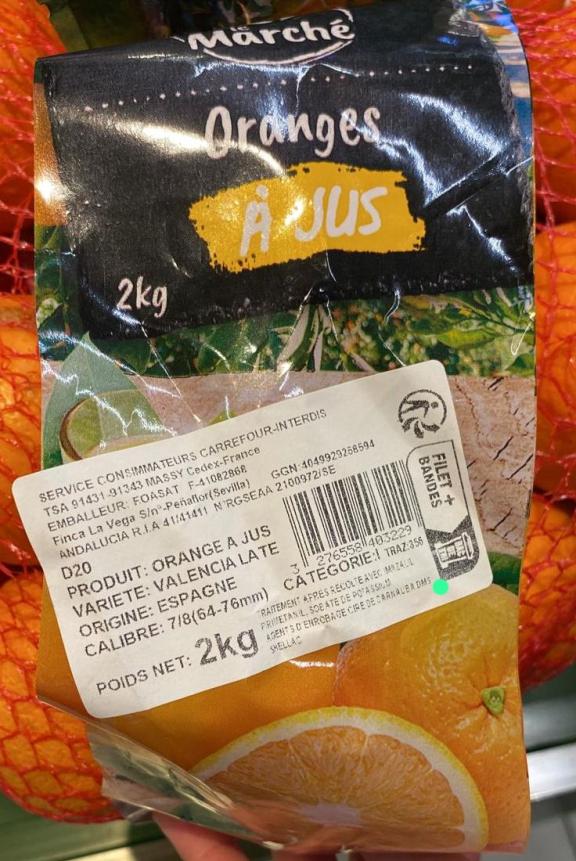
Source: ICI Business
Figure 4: Example of printed packaging for export
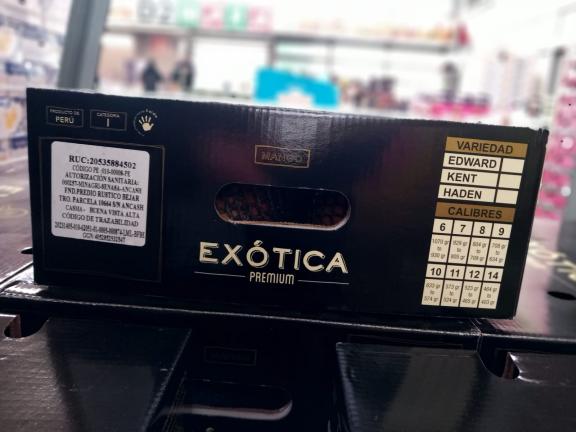
Source: ICI Business
Figure 5: Example of an export label
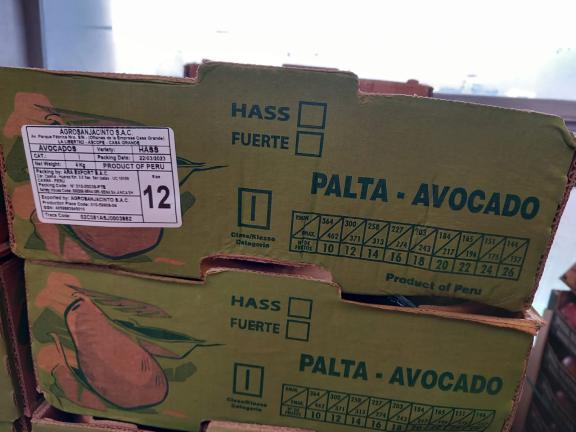
Source: ICI Business
When fruit or vegetables are processed or directly packed for consumption, you must include appropriate labelling for consumers:
- Common name of the product;
- Full name of the country of origin;
- Name and address of the producer, packer, importer, brand owner or seller (retailer) in the EU who places the product on the market, and the wording “Packed for” (if applicable);
- Net content in weight;
- Minimum durability – a best-before date (on all processed fruit and vegetables);
- Producer identification or lot number;
- List of ingredients (if applicable), including additives and post-harvest treatment;
- Allergenic declaration (if applicable);
- Declaration of nutritional value (when mixed with other foodstuffs);
- Packed in protective atmosphere, if applicable;
- Additional information about quality class, size, variety or commercial type and post-harvest treatment on the product labelling or in close proximity (on the shelf) for products with specific marketing standards.
The European Union (EU) requires that the text on the label must be written in one of the official languages of an EU Member State and be understandable for the consumer.
Figures 6: Examples of freshly cut fruit
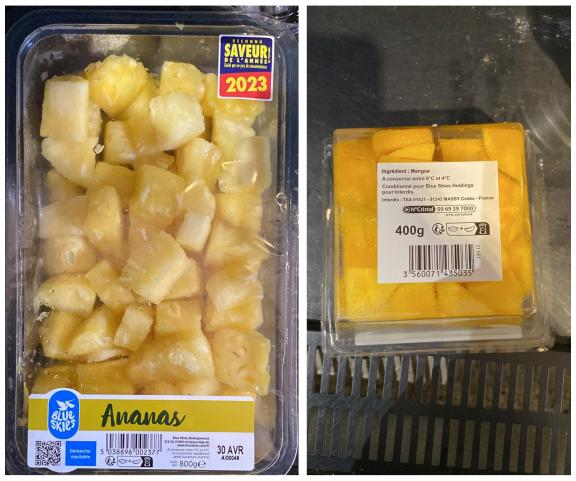
Source: ICI Business
Tips:
- Familiarise yourself with the procedures. See the CBI’s tips for organising your export to Europe. Failure to follow the right procedures could decrease and delay orders, increase costs and result in actions by European enforcement authorities. Check the documents needed for customs clearance in the European Union Access2Markets tool.
- Make sure that the accompanying documents (such as a Bill of Lading) correspond exactly to the food products contained in the consignment, including indicated volumes and weight, classes and sizes, number of pallets and boxes. Inadequate labelling can lead to fines and recalls. If your importer is forced to relabel boxes to avoid a fine, they could ask you to pay for the extra labour. The cost of labour in Europe is more expensive than in developing countries, so this could prove quite a costly option.
- Use the GS1 Legal Requirements for Labels on Fruit & Vegetables as a guideline on legal requirements for consumer units and trade units in the European Union. This guideline provides a great overview of labelling requirements for different consumer and trade packages. Also check out the European Commission’s Factsheet on Food Traceability.
Protective and sustainable packaging
Packaging marketed within Europe must comply with the general requirements and specific provisions. These aim at protecting the environment and preventing any risk to the health of consumers. The packaging must protect the product against contamination, leakage and dehydration. Also pay attention to your buyer’s preference for presentation, such as individual wrapping or sortation (for example, one side up). Products and packaging should be uniform.
In the future, you can expect stricter regulations on the use of plastic in packaging. The new EU Directive 2019/904 on the reduction of the impact of certain plastic products on the environment already intends to limit the use of single-use plastics by transferring the cost of waste and responsibility to the producer. With the European strategy for plastics, more and more buyers will demand alternative and environmentally friendly packaging.
Figure 7: Example of pre-packaged avocados
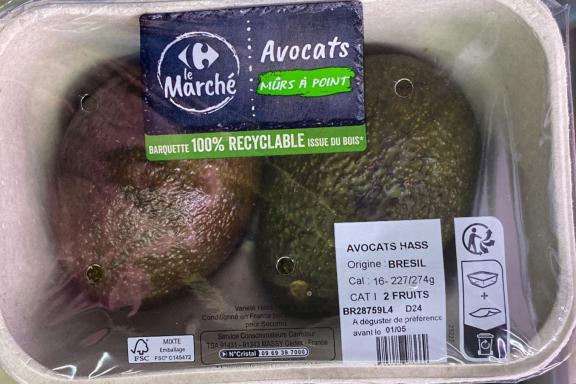
Source: ICI Business
Tips:
- Use good quality cartons to ensure your products are marketed correctly. Poor-quality boxes can often lead to the loss of boxes at the base of a pallet. You and your partners will lose money because the smashed fruit cannot be sold.
- Inform yourself well about packaging and labelling. Read more about labelling and packaging guidelines for foodstuffs in Access2Markets. If your product is pre-packed for retail, check the additional requirements in Regulation (EU) No 1169/2011 (version 1-1-2018) on the provision of food information to consumers. For instructions on handling, packaging and transport, see the FAO Recommended International Code of Practice for Packaging and Transport of Tropical Fresh Fruits and Vegetables.
- Contact Open Trade Gate Sweden if you have specific questions about the rules and requirements in Sweden and the European Union.
- Always discuss additional requirements with your buyer.
2. What additional requirements and certifications do buyers ask for in the fruit and vegetables sector?
European buyers often have specific requirements, depending on their sales channels and product segments. Common buyer requirements include GLOBALG.A.P. certification, and compliance with social and environmental standards.
Table 2: Most important certifications requested by fresh fruit and vegetable buyers
| Name of certification | Type | Cost for companies | Most used in European end-market(s) | Further Information on getting certification |
| GLOBALG.A.P. Integrated Farm Assurance (IFA) for fruit and vegetables | Agricultural practices | Total estimated certification costs: €1,000 – 2,500
Certificates are issued per product and are valid for one year. | Europe in general, in particular northern Europe and supermarket segments. | See GLOBALG.A.P. System Participation Fees 2024. Find your GLOBALG.A.P. Approved Certification Body (CB). Use the course catalogue to find training programmes. |
| GLOBALG.A.P. Risk Assessment on Social Practice (GRASP) | Social Add-on for GLOABLG.A.P. |
| Europe in general, in particular northern Europe and supermarket segments. | Read more about GRASP. |
| Sustainable Program for Irrigation and Groundwater Use (SPRING) | Sustainability Add-on for GLOABLG.A.P. |
| Europe in general, in particular northern Europe and supermarket segments. | Read more about SPRING. |
| International Featured Standards (IFS) | Food Safety | Total estimated certification costs: €2,000 – 4,500
The certificate is valid until the end of the second calendar year after the first certification date. | Germany, France, also recognised in many other European markets. | Search for recognised Food Certification Bodies and IFS consultants. Follow the IFS e-learning modules or find an IFS training provider. Use the smart phone application IFS Audit Manager to do a self-assessment |
| British Retail Consortium Global Standards (BRCGS) | Food Safety | Total estimated certification costs: €2,500 – 5,000
Recertification every 6 or 12 months, depending on your grading. | The UK retail market; also common in mainland Europe. | Read the steps how to get a Food Safety Certificate. Find a certification body in the BRCGS Directory. |
| Sedex Members Ethical Trade Audit (SMETA) | Social audit focused on working conditions | Total estimated certification costs: €1,000 – 3,000
A SMETA audit report is valid for 12 months from the date of issue. | Most European buyers, particularly the supermarket segment. | Familiarise yourself with Starting your compliance journey with a SMETA audit. |
Business Social Compliance Initiative (amfori BSCI) | Social audit focused on working conditions | The certification cost is not fixed, and it is agreed with the audit company. Generally, for SMEs the fee is similar to the SMETA audit costs, starting at around €1,000 | Germany The Netherlands | Check the list of amfori BSCI auditing companies. Find guiding documents in the BSCI resources |
| Rainforest Alliance | Environmental | There is no fixed fee. Request for the offer must be sent to the authorised certification body. Total cost include administrative costs, audit fees, a premium price paid to farmers, sustainability investment costs and a volume-based royalty. | Large retail chains in northwest Europe, and for high-risk products (e.g. avocados). | Find the authorised certification body in the Rainforest Alliance directory to ask for the certification cost. |
| Fairtrade | Sustainability and ethics | Certification costs depend on the number of hired workers, products and processing plants. Fees start at around €2,000. This includes the application fee, the certification fee and the processing fee. | The United Kingdom, Germany, Benelux and for typical smallholder products (e.g. bananas). | Check the Fairtrade Fee Calculator to make a first assessment of potential certification costs. |
| Organic | Sustainability, environmental | Average fees are around €2,000 for SMEs and the certificate must be renewed every year. Smallholder farmer groups with an internal control system (ICS) are limited to 2,000 farmers, and certification will be several times higher due to the high number of inspections and sampling. | European Union. All European countries have their own national organic labels. | Search the List of Recognised Authorities and Control Bodies for a contact in your country. Find more detailed information in the REGULATION (EU) 2018/848 on organic production and labelling of organic products (consolidated version of 1-12-2024). |
Source: ICI Business
* Additional implementation costs may include consultancy, training, internal preparations and adjustments.
** Total certification costs depend on your location, company size, complexity and the Certifying Body (CB). CB fees include audit time and travel costs and can be significantly higher if the CB is not based in your country.
Certification as guarantee
As food safety is a top priority in all European food sectors, you can expect most buyers to request extra guarantees from you in the form of certification. All buyers in the supply chain, such as traders, food processors and retailers, require the implementation of a food safety management system based on hazard analysis and critical control points (HACCP).
GLOBALG.A.P.
GLOBALG.A.P. (Good Agricultural Practices) is a private, voluntary certification scheme. Buyers of fresh fruit and vegetables in Europe often request this. The certification covers a variety of agricultural practices, ranging from crop management to worker health and environmental concerns. Complying with this certification proves that you have set up and documented a system of good agricultural practices. Buyers can sell GLOBALG.A.P.-certified goods more easily to different European supermarkets. It has become a minimum standard for buyers supplying European supermarkets.
Food safety management systems
Depending on the clients of your buyer, you may need to meet other safety management systems. Buyers in the UK typically look for BRC Global Standards, which are also recognised in several European nations. BRC standards have specific requirements for hygiene and food safety. Food processors and retailers use them.
Another important system is the IFS food standard, which focuses on food safety and quality. IFS was developed by the German Retail Federation (HDE) and the French Retail Federation (FDC). It is widely used by food manufacturers and retailers in Europe.
Alternative food safety management certification includes the Safe Quality Food (SQF) programme and FSSC 22000, an industry-developed standard developed by the International Organisation for Standardization (ISO).
All the mentioned management systems are recognised by the Global Food Safety Initiative (GFSI), which means that major retailers generally accept them. Compliance with certification schemes varies between countries, trade channels and market situations. Buyers can be more lenient during supply shortages, but in general, you can only do business when certifications and standards are in place. Living up to these standards will only become stricter and more widespread in the future.
Tips:
- Check with your buyer about their preferred food safety management system and certifications, which are often market-specific. At the least, become familiar with GLOBALG.A.P., as your EU market entry preparation is certain to include GLOBALG.A.P. certification.
- Follow the FAO Guidelines for the implementation of HACCP. You should also implement a food safety management system.
Social and environmental compliance
People in Europe are increasingly worried about social and environmental issues when they shop. They want to know the products they buy are made with care for social issues. For example, their products should not be made using child labour and their workers should be treated well and paid fair wages. Consumers are also becoming more aware of the environment and prefer to buy items that are better for the planet and support sustainability.
The focus on corporate social responsibility (CSR) is different across Europe. In Eastern Europe, not as many consumers demand strict social standards, while larger companies in Western and Northern Europe often have their own rules. For instance, Unilever has a Sustainable Agriculture Code, and Tesco offers a Nurture accreditation. The latter was under review but has since resumed. Sometimes, paying more attention to social and environmental issues means taking specific steps, like managing water use in dry regions and ensuring that workers earn a decent living.
As an exporter, you need to implement standards, especially when dealing with buyers that are linked to retail chains. The most common social standard in fresh fruit and vegetables is SMETA. SMETA (Sedex Members Ethical Trade Audit) is one of the most-used social audit methodologies in the world. It is designed to help companies assess and improve their supply chains’ social and ethical performance.
GLOBALG.A.P. has also developed a module that accounts for social concerns. This module is called GRASP (GLOBALG.A.P. Risk Assessment on Social Practice). It focuses on social aspects and is designed to assess and promote good social practices in agricultural production.
Amfori BSCI (Business Social Compliance Initiative) is known in northwestern Europe. It includes a code of conduct for all its participants, and amfori BEPI for environmental performance.
Rainforest Alliance certification is also gaining importance in supporting climate-smart agriculture and helping reduce climate change.
Fairtrade labels are not on the top of the list of buyers because of their complex requirements and high costs. Fairtrade is most often used for the largest product categories such as bananas.
The IDH Sustainable Trade Initiative has a Sustainability Initiative [for] Fruit and Vegetables (SIFAV). This is a pan-European covenant with over 30 partners, including retailers, brands, traders and civil-society organisations. The 2025 strategy focuses on reducing the environmental footprint across the supply chain, improving working conditions, wages and incomes, and strengthening due diligence reporting and transparency. In the near future, you can expect more buyers that will ask for new standards, such as GLOBALG.A.P. SPRING, paying a Living Wage or TÜV Rheinland’s tool for calculating the Corporate Carbon Footprint (CCF).
The Green Deal
Over the next few years, the European Green Deal will shape how resources are managed and how greenhouse gas emissions are cut. New EU sustainability policies aim to make Europe the first climate-neutral continent by 2050.
The Farm to Fork Strategy is central to this deal, focusing on creating food systems that are fair, healthy and eco-friendly. It will promote sustainable food production and tackle issues like packaging and food waste. EU trade agreements with various countries already include guidelines for trade and sustainable development. Fresh fruit and vegetable suppliers should prepare for rising standards and stay ahead of these changes.
Tips:
- Implement at least one environmental and one social standard. See the Basket of Social Standards and the Basket of Water Standards of The Sustainable Trade Initiative for Fruit and Vegetables (SIFAV).
- Find out about specific sourcing information of large retail chains. You can usually find these on their corporate websites, for example the approach to sourcing fruit, vegetables and salad crops by Marks & Spencer.
- Explore new standards. Consult the ITC Standards Map App for the different labels and to learn about differences between social and environmental standards.
Soft skills and company performance are also important
To sell fresh products in Europe, you have to meet food safety rules, quality standards and certification requirements. However, this does not guarantee success. Buyers want to feel they can trust you and rely on you, and big retailers prefer less hassle. This means your soft skills and how you perform are just as important as your products and certifications. Key factors in the fresh trade include timely deliveries, clear communication and sticking to agreements.
Be cautious of buyers with bad reputations or those who only show short-term interest. In this fast-paced market, decisions may need to be made quickly. For example, your products may need to be sold for very low prices if quality drops or demand decreases. European buyers often avoid taking losses and may claim quality issues instead. It’s essential to handle claims professionally, whether they are valid or not.
Tips:
- Make sure that you are well organised as a company. Good organisation skills include maintaining good logistical planning, documenting your shipments (including proof of quality), responding to your emails within a day and being professional in every aspect of the business.
- Do not put your product in consignment with a buyer which you do not know. Consignment is becoming less of a standard practice, and it increases your risks significantly.
- Establish and confirm agreements with your buyer on important topics such as delivery and payment terms, product specifications and certifications.
- Read the Tips for doing business with European buyers of fresh fruit and vegetables on CBI’s market intelligence platform.
3. What are the requirements and requested certifications in the niche fruit and vegetable markets?
In addition to the official and common requirements, specific requirements apply to niche markets, such as organic and fairtrade fruit and vegetables.
Organic certification
To market organic products in Europe, you have to use organic production methods according to European legislation. Since January 2025, it is mandatory to follow the EU organic regulation (EU) 2018/848 (consolidated version 1-12-2024), laying down the rules on organic production and labelling. A number of delegated and implementing regulations foresees in the legislation for trade in organic products. Inspection of organic products has become strict to prevent fraud. As a third-country producer, you will have to comply with the same set of rules as those producing in the European Union.
To get certified as an organic farmer or exporter, you must be registered and certified through a recognised control body or accredited certifier. This control body is responsible for verifying that you comply with the organic rules through an annual inspection and a set of checks. After being audited by an accredited certifier, you can use the EU organic logo on your products, along with the logo of the standard holder (see Figure 8).
All organic products imported into the EU must have the appropriate electronic certificate of inspection (e-COI). These certificates are managed through the Trade Control and Expert System (TRACES). If you do not have an electronic certificate of inspection, your products will not be released from their port of arrival in the European Union.
Conversion period
Any farm that wishes to produce organically has to undergo a process known as 'conversion'. During this period, organic production methods need to be used but the resulting product cannot be sold as organic. The conversion period for crop plots generally takes two years. For orchards of perennial soft, top and vine fruits, it is three years. The period can be shorter for areas for which you can prove no non-organic treatment has taken place.
The conversion period can be a difficult period for organic farms. In the first years, organic methods often result in lower yields while there is no price premium for crops in conversion. Maintaining the required soil fertility and water retention, avoiding cross-contamination, and using organic inputs and reproductive materials can also be a challenge for farmers in countries with tropical climates or with limited access to organic reproductive material and inputs.
Group certification
Under the new regulation, smallholder farmers can apply for group certification if they have an Internal Control System (ICS). However, their group size is limited to 2,000 farmers that either have less than five hectares or a turnover of less than €25,000.
National differences
Some European countries may prefer a national organic standard, which is in line with the EU certification but often exceeding its requirements. National standards can be an addition when supplying specific markets, for example Naturland in Germany, KRAV in Sweden and BioSuisse in Switzerland.
Figure 8: The official organic logo for organic products in Europe
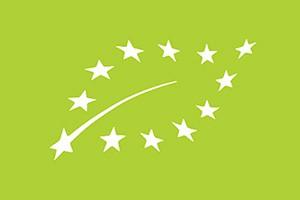
Source: European Commission
Tips:
- Assess the organic market potential for your specific product. Inform yourself well, because implementing organic production and becoming certified can be expensive and time-consuming. You can find a List of Recognised Control Authorities and Control Bodies on the European Commission’s website.
- Find importers that specialise in organic products through trade fairs such as Biofach or Fruit Logistica and company directories such as the International directory of organic food wholesale & supply companies (Organic-bio). Specialised organic importers often play an active role in advising and guiding producers.
- Read more about organic farming on an informative website of the European Commission on organic farming, and find more information on Trade in organics.
- For smallholder certification and the impact of the new EU rules, see the CBI Webinar 'The EU organic market explained – Opportunities and new rules'.
Fairtrade and environmental labels
Fairtrade and eco-friendly product labels are special features that can help your product stand out and catch the attention of shoppers who care about the environment. These labels are designed for consumers and are especially relevant for small farm crops and popular fruits and vegetables. You can often find these labels on fruits like bananas, pineapples and coconuts. Well-known labels include:
Tips:
- Consult the Standards Map database for a list of labels, along with their similarities and differences. Enter your product, country and destination country to find certification schemes and labels that fit your product.
- Find a specialised European buyer who is familiar with these social product labels if you choose to certify your production.
Thierry Paqui carried out this study in partnership with ICI Business and GloballyCool on behalf of CBI.
Please review our market information disclaimer.
Search
Enter search terms to find market research

